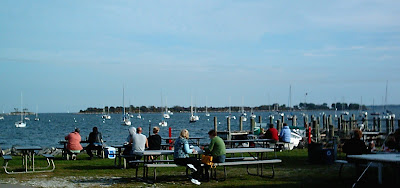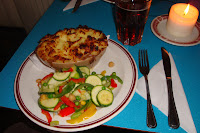 Not the monster mash, but mash house. My stay here in Birmingham, England started out on a very sour note. Although my Ryan Air flight was on time and flawless, and I picked up my Hertz rental car in short order, and I even had a nice lunch in a local pub along with a pint, I eventually found the Warwick Castle (pronounced Warrick), albeit after a few nerve shattering errors as I tried to get used to driving on the left side of the road. The castle was impressive, if expensive. The rooms were full of figures Madam Tussaud dressed in period clothing and staged in the midst of medieval tasks. There were weapon rooms, suits of armor, and lots of art and furniture spanning the centuries the castle has been in use, all the way up to the introduction of electricity and beyond in the latter part of the 19th century. There was even of portion of the original castle built in 1068 by the order of William the Conqueror. The castle closed and we were off.
Not the monster mash, but mash house. My stay here in Birmingham, England started out on a very sour note. Although my Ryan Air flight was on time and flawless, and I picked up my Hertz rental car in short order, and I even had a nice lunch in a local pub along with a pint, I eventually found the Warwick Castle (pronounced Warrick), albeit after a few nerve shattering errors as I tried to get used to driving on the left side of the road. The castle was impressive, if expensive. The rooms were full of figures Madam Tussaud dressed in period clothing and staged in the midst of medieval tasks. There were weapon rooms, suits of armor, and lots of art and furniture spanning the centuries the castle has been in use, all the way up to the introduction of electricity and beyond in the latter part of the 19th century. There was even of portion of the original castle built in 1068 by the order of William the Conqueror. The castle closed and we were off.
And that is when the trouble began. The plan was to take a quick drive to Stratford upon Avon, the namesake of the town were I spent my teen years. It is only about ten miles away so it seemed easy enough. The reality could not have been further from the truth. The A46 was closed due to an accident, and I spent the next four hours trying to get the forty miles to my hotel in Birmingham. I abandoned the idea of stopping in Stratford upon Avon after being grazed by a truck, scratching my rental car. The gentleman was calm as he explained that there was simply no way it could have been his fault, even though my car was not moving. I was sitting with my turn signal on trying to merge into the barely moving traffic.
So I spent a few hours in England, learning to drive on the left side of the road, in pouring rain, on country roads, wishing that every hotel I passed was my hotel. But they were not and I finally made it into Birmingham city center. The hotel I booked is under construction and has no sign. Another ½ hour was spent trying to find my hotel, which I finally did. After an overpriced meal at the bar of the hotel because I was too tired and stressed to go anywhere else, my son and I retired to our room. And retire we did. I awoke at eight in the morning and awoke my son, twice. Seeing the futility in this plan, I returned to bed, watched some television (The Rockford Files) and went back to sleep. We woke up around noon to the sound of a jack-hammer on the floor above us, putzed around and finally made it outside just shy of two P.M., heading off to the historic canals of Birmingham. The day got better. Birmingham seemed to be a great city, balancing its history with the city’s forward momentum and growth.
The historic canals are flanked by cafés, coffee houses, restaurants, and the very modern International Convention Center, Symphony Hall, and a mixed use development called The Mailbox. They are also building a massive square mixed use building aptly named The Cube.
After looking at a number of options for dining including what amounts to floating diners on converted long boats that used to carry so many goods up and down the canals, we settled on a place called The Mash. The instructions are simply laid out; 1. Choose for Pie or Sausage, 2. Choose your mash. Options range from cheddar mash, to horseradish mash, colcannon, house mash, and more. 3. Choose your gravy. Options included tarragon creamy gravy, house gravy, and more. You can also have additional veggies, salad, and a few other options for main courses.
I chose the steak and kidney pie because I am in England and no doing so would be akin to not having pizza when in Naples, Italy or not having haggis when in Scotland (which I will be trying in the next few days). I chose colcannon and tarragon gravy to go with it. My son had three sausage plate: lamb and mint, pork and apple, and honey mustard. He chose the cheddar mash and house gravy. Our food arrived promptly and displayed attractively enough. The steak and kidney pie was rich and flavorful, a dark gravy containing chucks of tender beef and the earthy flavor indicating the presence of the kidneys encased in a flaky, nicely browned pastry shell. The colcannon was very nicely prepared. The greens still had some texture and the potatoes were creamy and rich. The gravy was tasty enough, but lacked any flavor of tarragon. The sausages were nicely browned and very moist. The lamb and mint tasted as one would think, the pork and apple had a very subtle flavor of apples, and most surprising was the honey mustard sausage. I was nervous when my son ordered it. I have been inundated with grossly-sweet goopy honey mustard things in America and I was afraid that this might resemble those disgusting concoctions. To the contrary, the mustard has a hint of spiciness and the honey played a restrained supporting role. His cheddar mash was nicely balanced, not too cheesy, but had the flavor of sharp cheddar in every bite. The gravy was good too.
After our meal, I peered into the small kitchen and saw a Rational Self Cooking Center there. I pulled out my business card and handed it to the young man working there, informing him of my position with the company. After a series of questions from me, I learned that the food is prepared off premises and brought in frozen. The entrée items are placed in the Self Cooking Center on the “level control” setting. This setting is where each shelf gets its own timer that self adjust for recovery time each time the door is opened. The mashed potatoes were microwaved, and the gravy was remarkably tasty for being from a dry product that was mixed with boiling water.
The pies and sausages are cooked from frozen. I would have never guessed. This is exciting because I have been telling my customers and prospective customers that this machine could revolutionize the way they operate their kitchens. I have demonstrated this capability many times, but it is very theoretical in demo. Here I was witnessing a concept that was built around the Self Cooking Center and its advanced capabilities. They have already signed on two companies in America to franchise the concept. They will be opening 6 stores per year, half of which will be franchised, the others owned by the company.
It is only a matter of time before our country gets around to implementing what the Europeans have know for a long time: technology can increase quality, reduce food and labor costs, and allow your kitchen to be a fraction of the size of what we are used to.
If I can’t get my customers to see this, then I just might have to do it myself. Stay Tuned.
 2008 was my whiskey year. I went to distilleries in Scotland, Northern Ireland, Tennessee and Kentucky. I have tried at least 60 different whiskies. After a trip to the Highland Cigar Bar a couple of weeks ago I decided to do a whisky dinner. Notice there is no "e" in whisky. That is because I decided to focus on Scotch Whisky after my friend told me that my Christmas present will be 11 pounds of peat. That's right, you can buy peat. That knowledge really got my brain working... I can smoke my own salmon with peat, I can cure and smoke my own bacon with peat... fun stuff.
2008 was my whiskey year. I went to distilleries in Scotland, Northern Ireland, Tennessee and Kentucky. I have tried at least 60 different whiskies. After a trip to the Highland Cigar Bar a couple of weeks ago I decided to do a whisky dinner. Notice there is no "e" in whisky. That is because I decided to focus on Scotch Whisky after my friend told me that my Christmas present will be 11 pounds of peat. That's right, you can buy peat. That knowledge really got my brain working... I can smoke my own salmon with peat, I can cure and smoke my own bacon with peat... fun stuff.




















